Self-Organizing IoT Device-Based Smart Diagnosing Assistance System for Activities of Daily Living
Abstract
:1. Introduction
2. Related Research
2.1. Activities of Daily Living
2.2. Ambient Assist Living and Smart Home Technology
3. Test Scenario and Proposed System Architecture
3.1. Scenario for ADL Test
3.2. Smart ADL Diagnosing Assistance System
4. Detailed Design
4.1. Location System
4.2. Resource Device
4.2.1. Stationary Resource Device
4.2.2. Mobile Identification Device
4.2.3. ADL Activity Report
4.2.4. Entrance Recognition System
4.2.5. External Sensor Device
5. Implementation and Evaluation
5.1. Implementation of Smart Diagnosing System
5.2. Test Analisys of ADL Diagnosing System
5.3. Response Time and Power Consumption of ADL Report Protocol
5.4. Response Time of Entrance Recognition
6. Conclusions
Author Contributions
Funding
Institutional Review Board Statement
Informed Consent Statement
Acknowledgments
Conflicts of Interest
References
- Schika, J.A. Use of Informants to Identify Mild Cognitive Impairment in Older Adults. Curr. Psychiatry Rep. 2010, 12, 4–12. [Google Scholar] [CrossRef] [PubMed]
- Barbosa, A.F.; Chen, J.; Freitag, F.; Valente, D.; Souza, C.D.O.; Voos, M.C.; Chien, H.F. Gait posture and cognition in Parkinson’s disease. Dement. Neuropsychol. 2016, 10, 280–286. [Google Scholar] [CrossRef] [PubMed]
- Hausdorff, J.M. Gait dynamics in Parkinson’s disease: Common and distinct behavior among stride length gait variability and fractal-like scaling. Chaos 2009, 19, 026113. [Google Scholar] [CrossRef] [PubMed] [Green Version]
- Joshi, D.; Khajuria, A.; Joshi, P. An automatic non-invasive method for Parkinson’s disease classification. Comput. Method Program Biomed. 2017, 145, 135–145. [Google Scholar] [CrossRef] [PubMed]
- Paragliola, G.; Coronato, A. Gait anomaly detection of subjects with Parkinson’s disease using a deep time series-based approach. IEEE Access 2018, 6, 73280–73292. [Google Scholar] [CrossRef]
- Farias, S.T.; Park, L.Q.; Harvey, D.J.; Simon, C.; Reed, B.R.; Carmichael, O.; Mungas, D. Everyday cognition in older adults: Associations with neuropsychological performance and structural brain imaging. J. Int. Neuropsychol. Soc. 2013, 19, 430–441. [Google Scholar] [CrossRef] [PubMed] [Green Version]
- Jekel, K.; Damian, M.; Wattmo, C.; Hausner, L.; Bullock, R.; Connelly, P.J.; Frölich, L. Mild cognitive impairment and deficits in instrumental activities of daily living: A systematic review. Alzheimer’s Res. Ther. 2015, 7, 17. [Google Scholar] [CrossRef] [Green Version]
- Li, Y.; Zhuang, Y.; Lan, H.; Zhang, P.; Niu, X.; El-Sheimy, N. Wi-Fi-Aided magnetic matching for indoor navigation with consumer portable devices. Micromachines 2015, 6, 747–764. [Google Scholar] [CrossRef] [Green Version]
- Wang, E.; Wang, M.; Men, Z.; Xu, X. A study of WiFi-aided magnetic matching indoor positioning algorithm. J. Comput. Commun. 2017, 5, 91–101. [Google Scholar] [CrossRef] [Green Version]
- Sridharan, M.; Bigham, J.; Phillips, C.; Bodanese, E. Collaborative location estimation for confined spaces using magnetic field and inverse beacon positioning. IEEE Sens. 2017, 1–3. [Google Scholar] [CrossRef]
- Jo, H.G.; Son, T.Y.; Jeong, S.Y.; Kang, S.J. Proximity-Based Asynchronous Messaging Platform for Location-Based Internet of Things Service. ISPRS Int. J. Geo-Inf. 2016, 5, 116. [Google Scholar] [CrossRef] [Green Version]
- Broe, G.A.; Jorn, A.F.; Creasey, H.; Grayson, D.; Edelbrock, D.; Waite, L.M.; Bennett, H.; Cullen, J.S.; Casey, B. Impact of chronic systemic and neurological disorders on disability, depression and life satisfaction. Int. J. Geriatr. Psychiatry 1998, 13, 667–673. [Google Scholar] [CrossRef]
- Bienkiewicz, M.M.; Brandi, M.L.; Goldenberg, G.; Hughes, C.M.; Hermsdörfer, J. The tool in the brain: Apraxia in ADL. Behavioral and neurological correlates of apraxia in daily living. Front. Psychol. 2014, 5, 353. [Google Scholar] [PubMed] [Green Version]
- Fauth, E.B.; Schwartz, S.; Tschanz, J.T.; Østbye, T.; Corcoran, C.; Norton, M.C. Baseline disability in activities of daily living predicts dementia risk even after controlling for baseline global cognitive ability and depressive symptoms. Int. J. Geriatr. Psychiatry 2013, 28, 597–606. [Google Scholar] [CrossRef] [Green Version]
- Hall, J.R.; Vo, H.T.; Johnson, L.A.; Barber, R.C.; O’Bryant, S.E. The link between cognitive measures and ADLs and IADL functioning in mild Alzheimer’s: What has gender got to do with it. Int. J. Alzheimer’s Dis. 2011, 2011, 276734. [Google Scholar] [CrossRef] [PubMed] [Green Version]
- Mlinac, M.E.; Feng, M.C. Assessment of activities of daily living self-care and independence. Arch. Clin. Neuropsychol. 2016, 31, 506–516. [Google Scholar] [CrossRef] [Green Version]
- Helvik, A.-S.; Engedal, K.; Benth, J.Š.; Selbæk, G. A 52 month follow-up of functional decline in nursing home residents—Degree of dementia contributes. BMC Geriatr. 2014, 14, 45. [Google Scholar] [CrossRef] [Green Version]
- Patel, S.; Mancinelli, C.; Bonato, P.; Healey, J.; Moy, M. Using Wearable Sensors to Monitor Physical Activities of Patients with COPD: A Comparison of Classifier Performance. Body Sens. Netw. 2009, 236–241. [Google Scholar] [CrossRef]
- Lara, O.D.; Pérez, A.J.; Labrador, M.A.; Posada, J.D. Centinela: A human activity recognition system based on acceleration and vital sign data. Pervasive Mob. Comput. 2012, 8, 717–729. [Google Scholar] [CrossRef]
- Saadeh, W.; Butt, S.A.; Altaf, M.A.B. A patient-specific single sensor IoT-based wearable fall prediction and detection system. IEEE Trans. Neural Syst. Rehabil. Eng. 2019, 27, 995–1003. [Google Scholar] [CrossRef]
- Ribeiro, J. Wearable technology spending: A strategic approach to decision-making. In Wearable Technology and Mobile Innovations for Next-Generation Education; IGI Global: Hershey, PA, USA, 2016; p. 37. [Google Scholar]
- Sridharan, M.; Bigham, J.; Campbell, P.; Phillips, C.; Bodanese, E. Inferring Micro-Activities Using Wearable Sensing for ADL Recognition of Home-Care Patients. IEEE J. Biomed. Health Inform. 2020, 24, 747–759. [Google Scholar] [CrossRef] [PubMed]
- Wu, J.; Feng, Y.; Sun, P. Sensor Fusion for Recognition of Activities of Daily Living. Sensors 2018, 18, 4029. [Google Scholar] [CrossRef] [PubMed] [Green Version]
- Uddin, M.; Khaksar, W.; Torresen, J. Ambient sensors for elderly care and independent living: A survey. Sensors 2018, 18, 2027. [Google Scholar] [CrossRef] [PubMed] [Green Version]
- Kon, B.; Lam, A.; Chan, J. Evolution of Smart Homes for the Elderly. In Proceedings of the 26th International Conference on World Wide Web Companion, Perth Australia, 3–7 April 2017; pp. 1095–1101. [Google Scholar]
- Ghayvat, H.; Awais, M.; Pandya, S.; Ren, H. Smart Aging System: Uncovering the Hidden Wellness Parameter for Well-Being Monitoring and Anomaly Detection. Sensors 2019, 19, 766. [Google Scholar] [CrossRef] [PubMed] [Green Version]
- Rashidi, P.; Mihailidis, A. A Survey on Ambient-Assisted Living Tools for Older Adults. IEEE J. Biomed. Health Inf. 2013, 17, 579–590. [Google Scholar] [CrossRef] [PubMed]
- Ghayvat, H.; Mukhopadhyay, S.; Shenjie, B.; Chouhan, A.; Chen, W. Smart home based ambient assisted living: Recognition of anomaly in the activity of daily living for an elderly living alone. In Proceedings of the 2018 IEEE International Instrumentation and Measurement Technology Conference (I2MTC), Houston, TX, USA, 14–17 May 2018; pp. 1–5. [Google Scholar]
- Alwan, M.; Dalal, S.; Mack, D.; Kell, S.; Turner, B.; Leachtenauer, J.; Felder, R. Impact of Monitoring Technology in Assisted Living: Outcome Pilot. IEEE Trans. Inf. Technol. Biomed. 2006, 10, 192–198. [Google Scholar] [CrossRef]
- Ni, Q.; Hernando, A.G.; de la Cruz, I. The Elderly’s Independent Living in Smart Homes: A Characterization of Activities and Sensing Infrastructure Survey to Facilitate Services Development. Sensors 2015, 15, 11312–11362. [Google Scholar] [CrossRef] [PubMed]
- Kodeswaran, P.; Kokku, R.; Mallick, M.; Sen, S. Demultiplexing activities of daily living in IoT enabled smarthomes. In Proceedings of the 35th Annual IEEE International Conference on Computer, San Francisco, CA, USA, 10–14 April 2016; pp. 1–9. [Google Scholar]
- Lee, Y.-S.; Chung, W.-Y. Visual Sensor Based Abnormal Event Detection with Moving Shadow Removal in Home Healthcare Applications. Sensors 2012, 12, 573–584. [Google Scholar] [CrossRef]
- Chung, K.; Song, K.; Shin, K.; Sohn, J.; Cho, S.; Chang, J.-H. Noncontact Sleep Study by Multi-Modal Sensor Fusion. Sensors 2017, 17, 1685. [Google Scholar] [CrossRef] [Green Version]
- Boyle, P.A.; Cohen, R.A.; Paul, R.; Moser, D.; Gordon, N. Cognitive and motor impairments predict functional declines in patients with vascular dementia. Int. J. Geriatr. Psychiatry 2002, 17, 164–169. [Google Scholar] [CrossRef]
- Yassine, A.; Singh, S.; Alamri, A. Mining human activity patterns from smart home big data for health care applications. IEEE Access 2017, 5, 13131–13141. [Google Scholar] [CrossRef]
- Moriya, K.; Nakagawa, E.; Fujimoto, M.; Suwa, H.; Arakawa, Y.; Kimura, A.; Miki, S.; Yasumoto, K. Daily Living Activity Recognition with Echonet Lite Appliances and Motion Sensors. In Proceedings of the 2017 IEEE International Conference on Pervasive Computing and Communications Workshops, Kona, HI, USA, 13–17 March 2017. [Google Scholar]
- Tan, T.-H.; Gochoo, M.; Jean, F.-R.; Huang, S.-C.; Kuo, S.-Y. Front-door event classification algorithm for elderly people living alone in smart house using wireless binary sensors. IEEE Access 2017, 5, 10734–10743. [Google Scholar] [CrossRef]
- Ghayvat, H.; Liu, J.; Mukhopadhyay, S.C.; Gui, X. Wellness sensor networks: A proposal and implementation for a smart home for assisted living. IEEE Sens. J. 2015, 15, 7341–7348. [Google Scholar] [CrossRef]
- Shin, Y.S.; Park, Y.J.; Kang, S.J. Data-Driven Knowledge-Based System for Self-Measuring Activities of Daily Living in IoT-Based Test. Appl. Sci. 2002, 10, 14. [Google Scholar]
- Park, Y.J.; Seong, K.E.; Jeong, S.Y.; Kang, S.J. Self-Organizing Wearable Device Platform for Assisting and Reminding Humans in Real Time. Mob. Inf. Syst. 2016, 2016, 6048213. [Google Scholar] [CrossRef] [Green Version]
- Park, S.-H.; Jeong, S.Y.; Kim, D.H.; Kang, S.J. Ubinos: The multi-threading OS for the resource-limited embedded system. In Proceedings of the 5th International Symposium on Embedded Technology, Phoenix, AZ, USA, 23–24 January 2010; pp. 501–502. [Google Scholar]


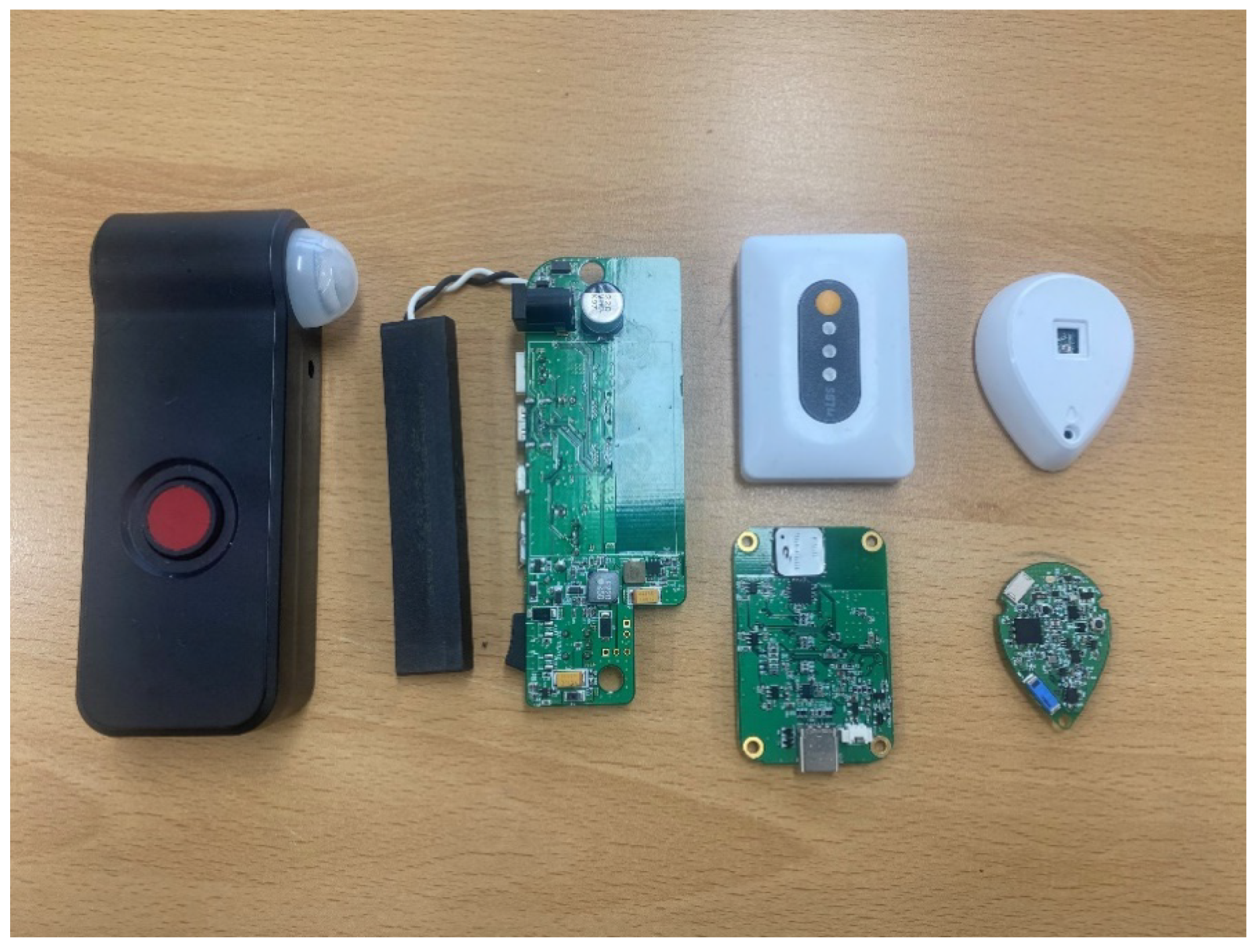
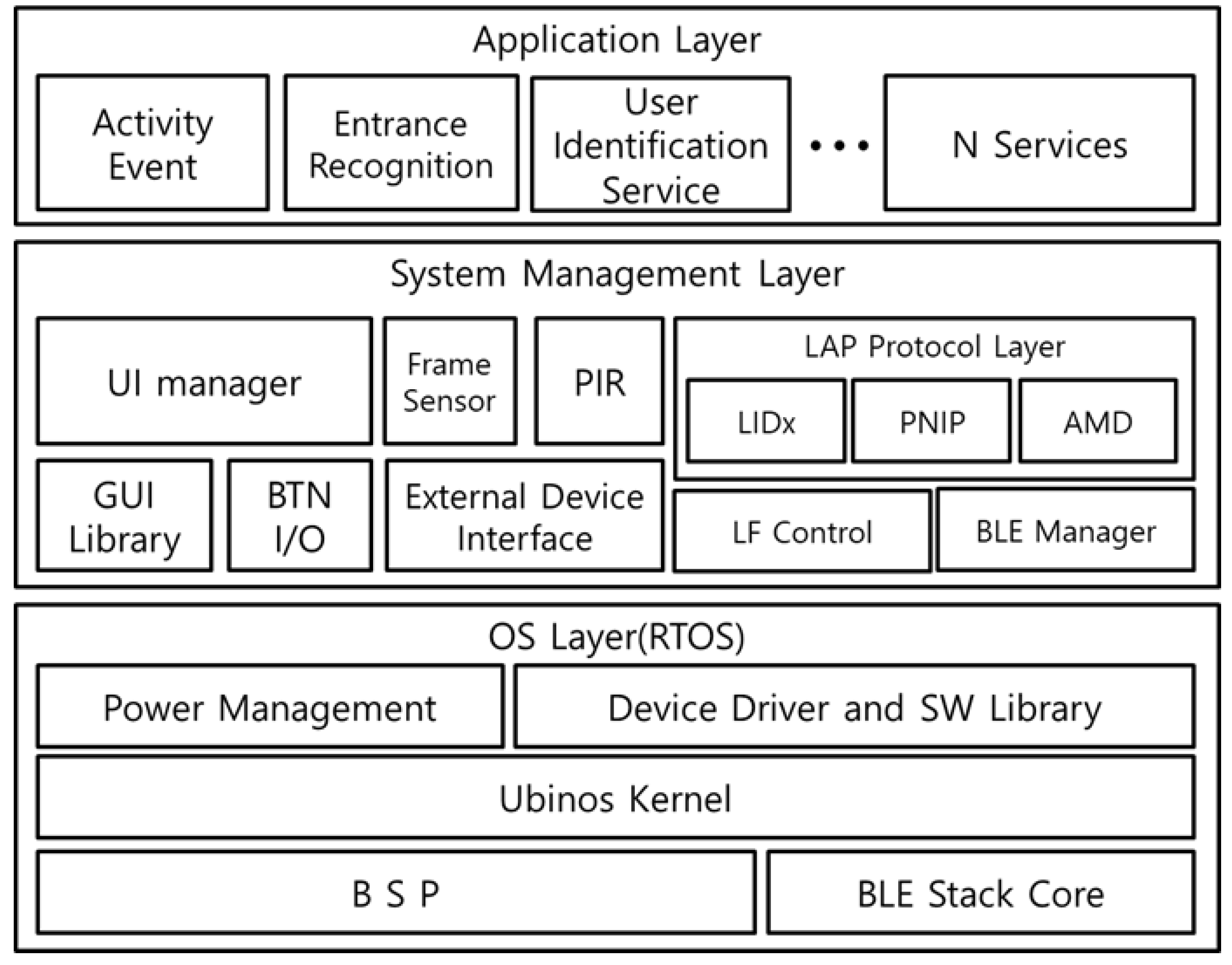

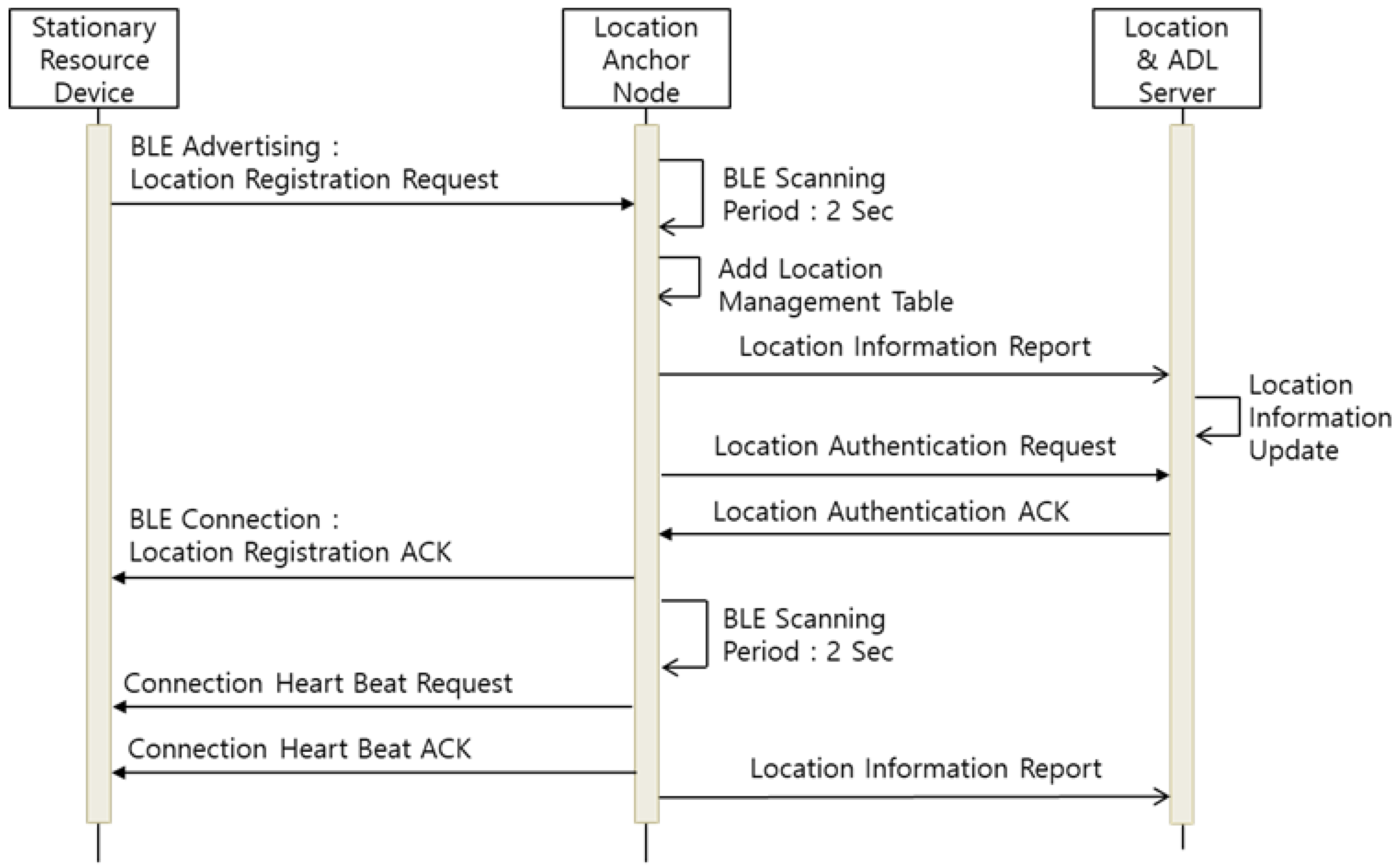

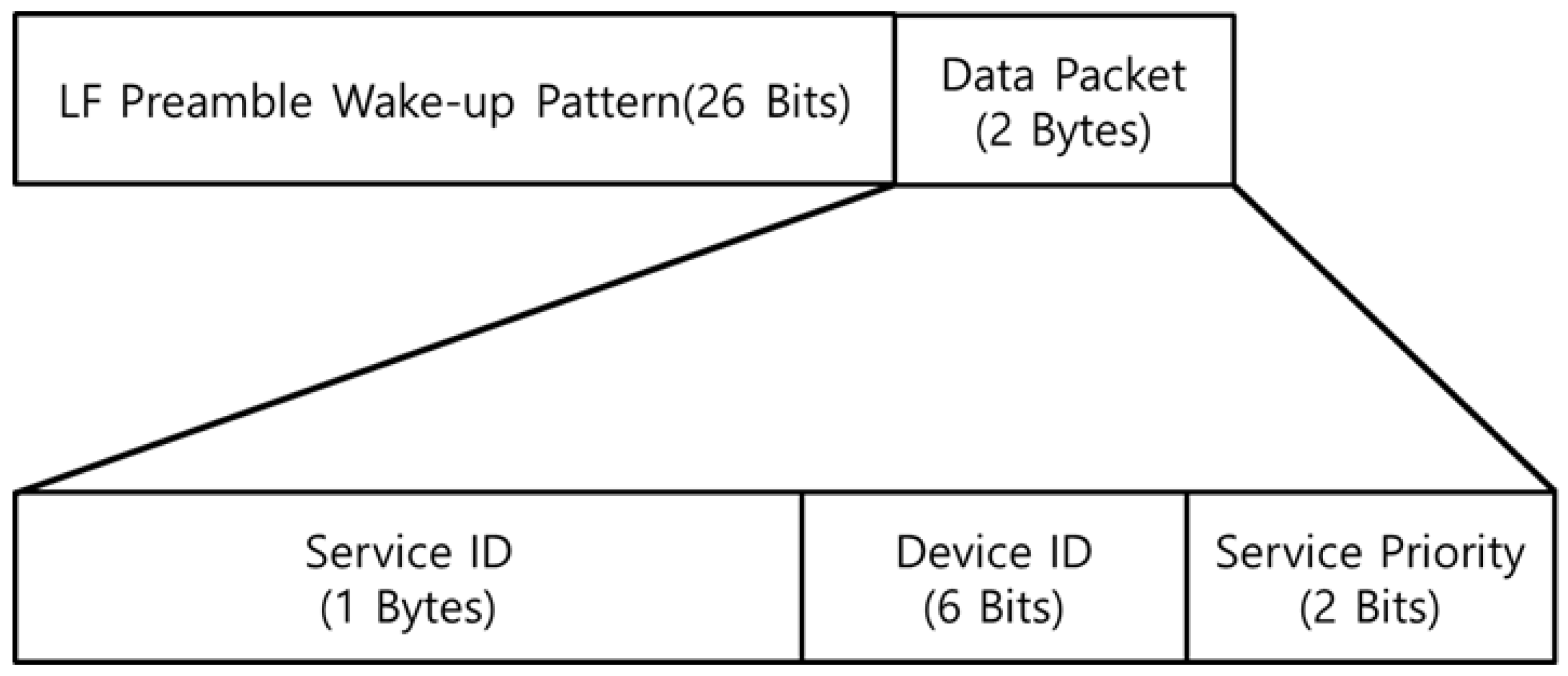

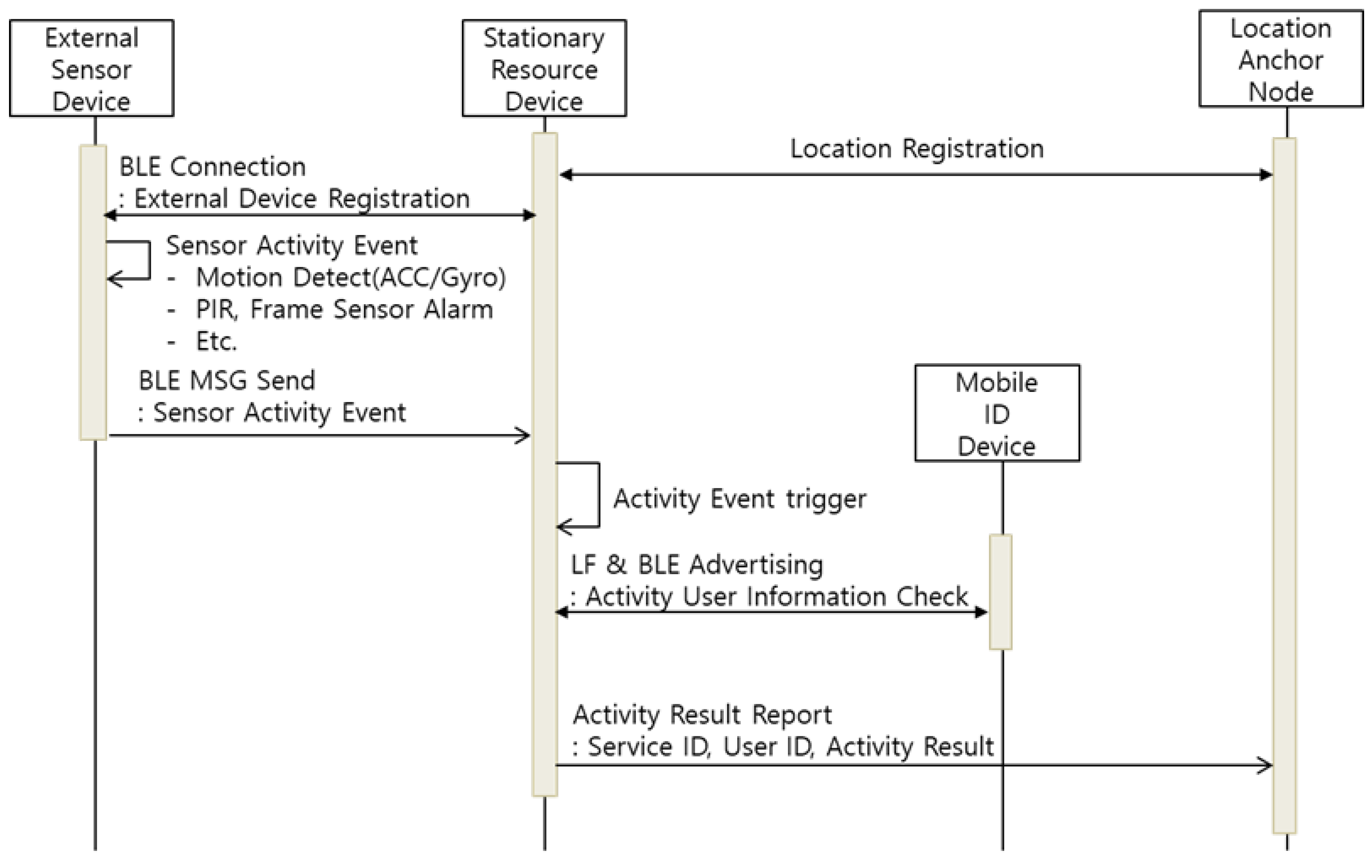


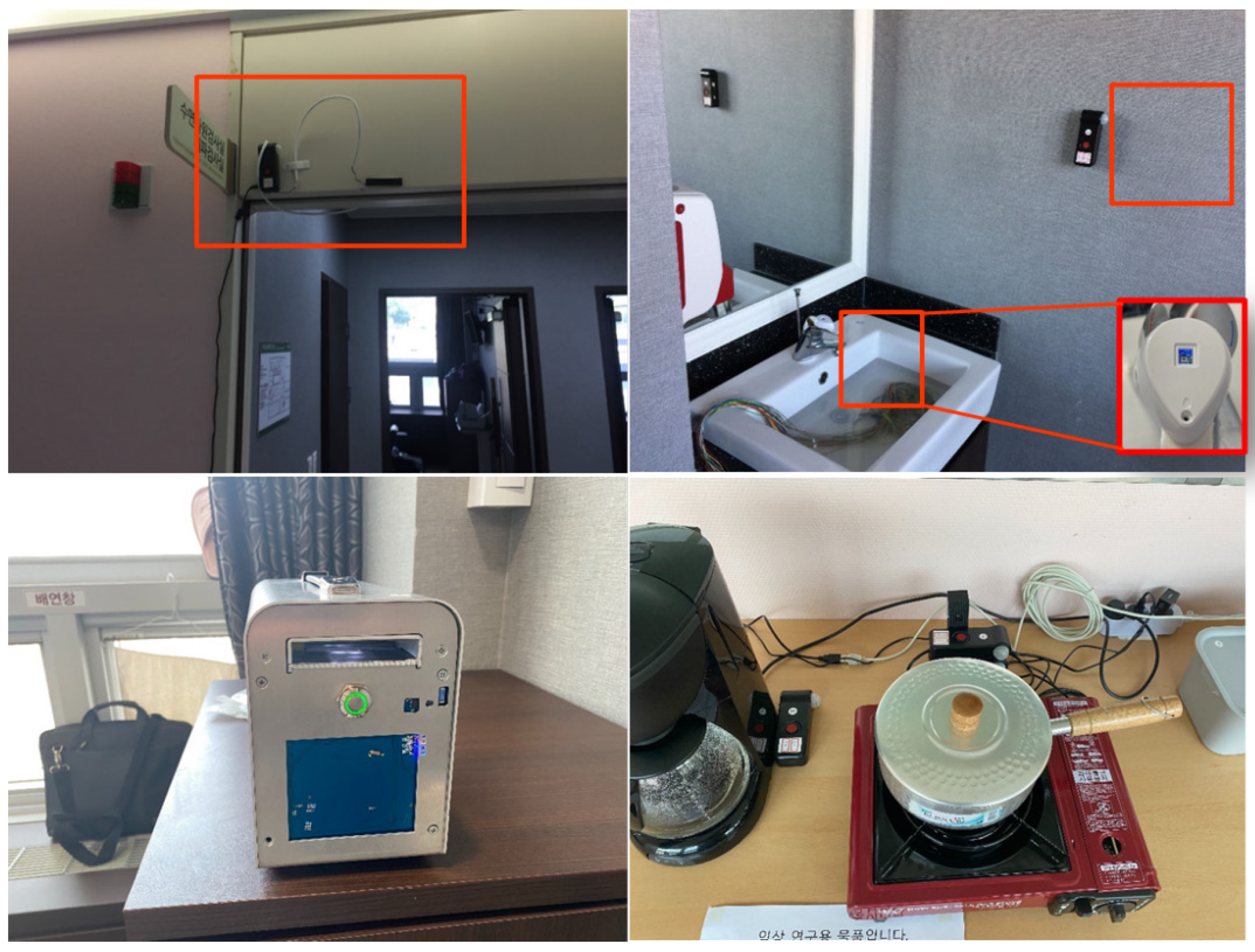
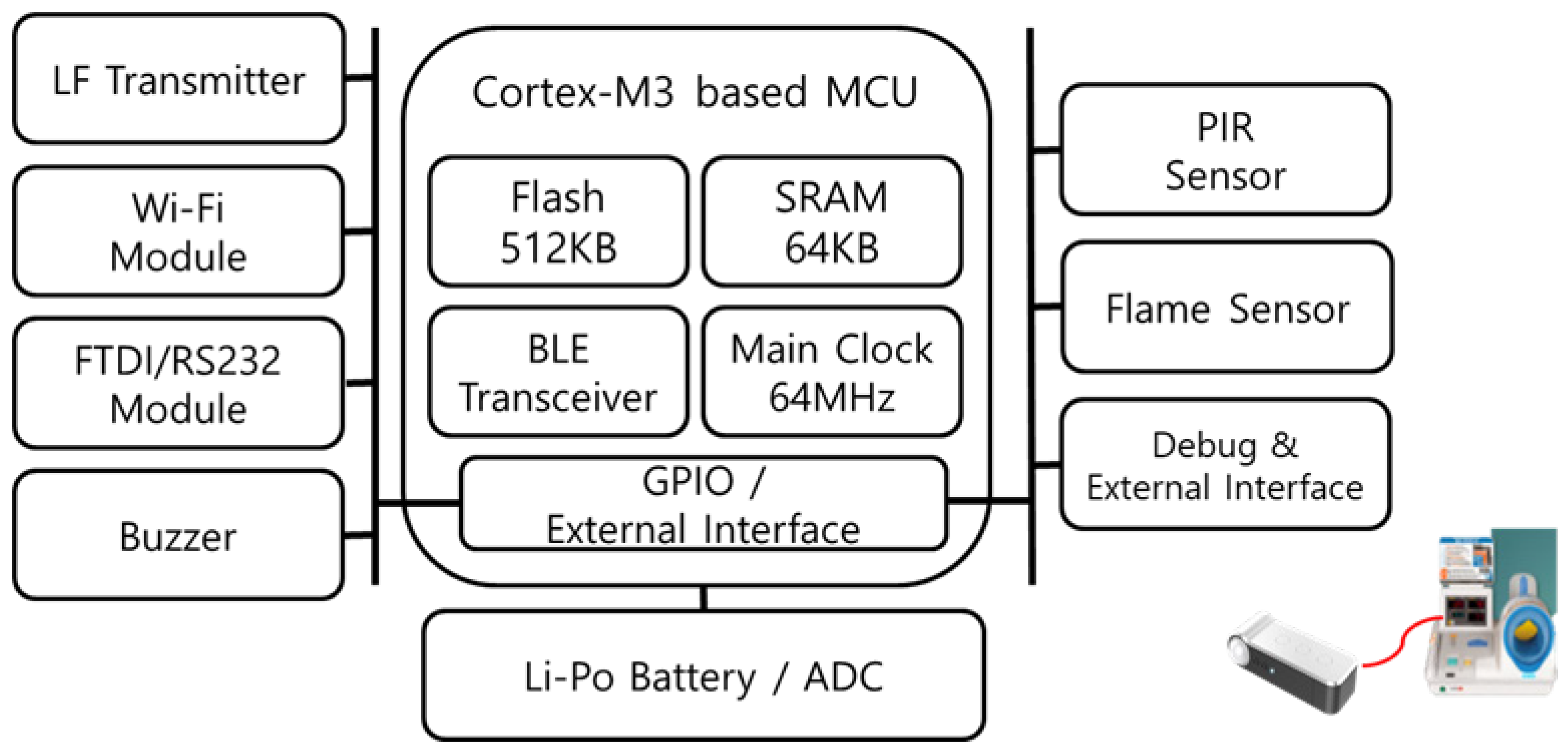
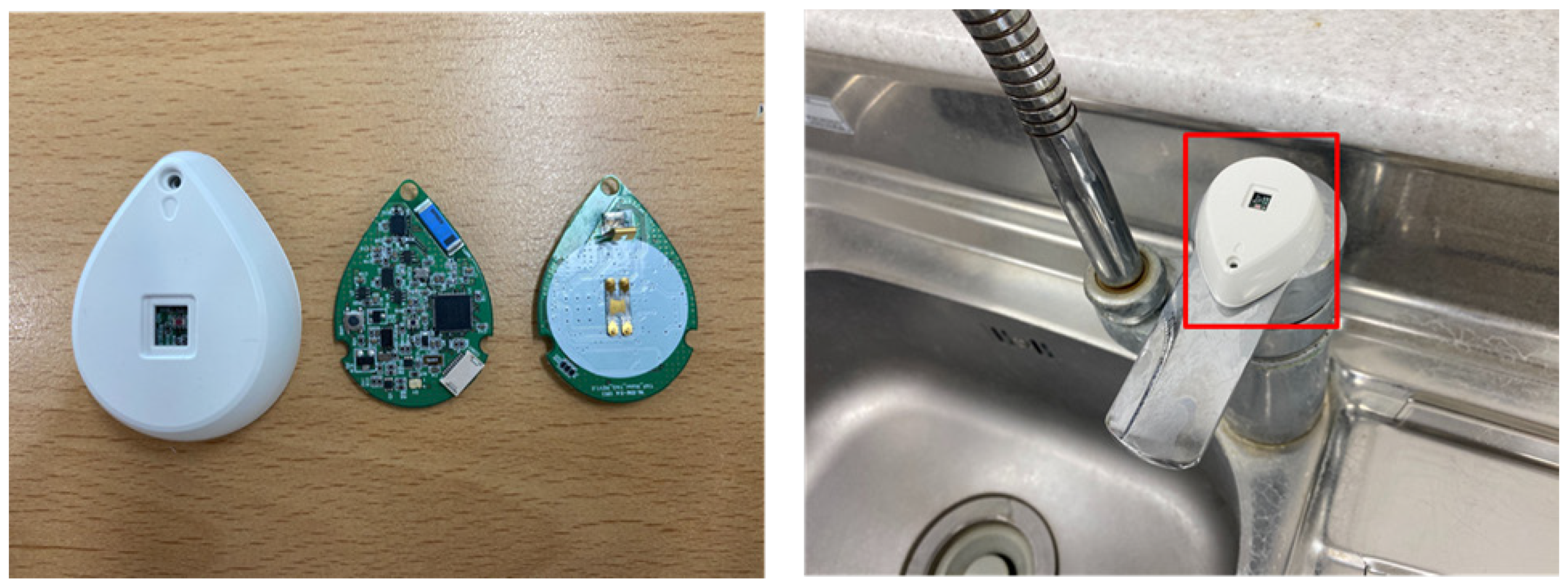
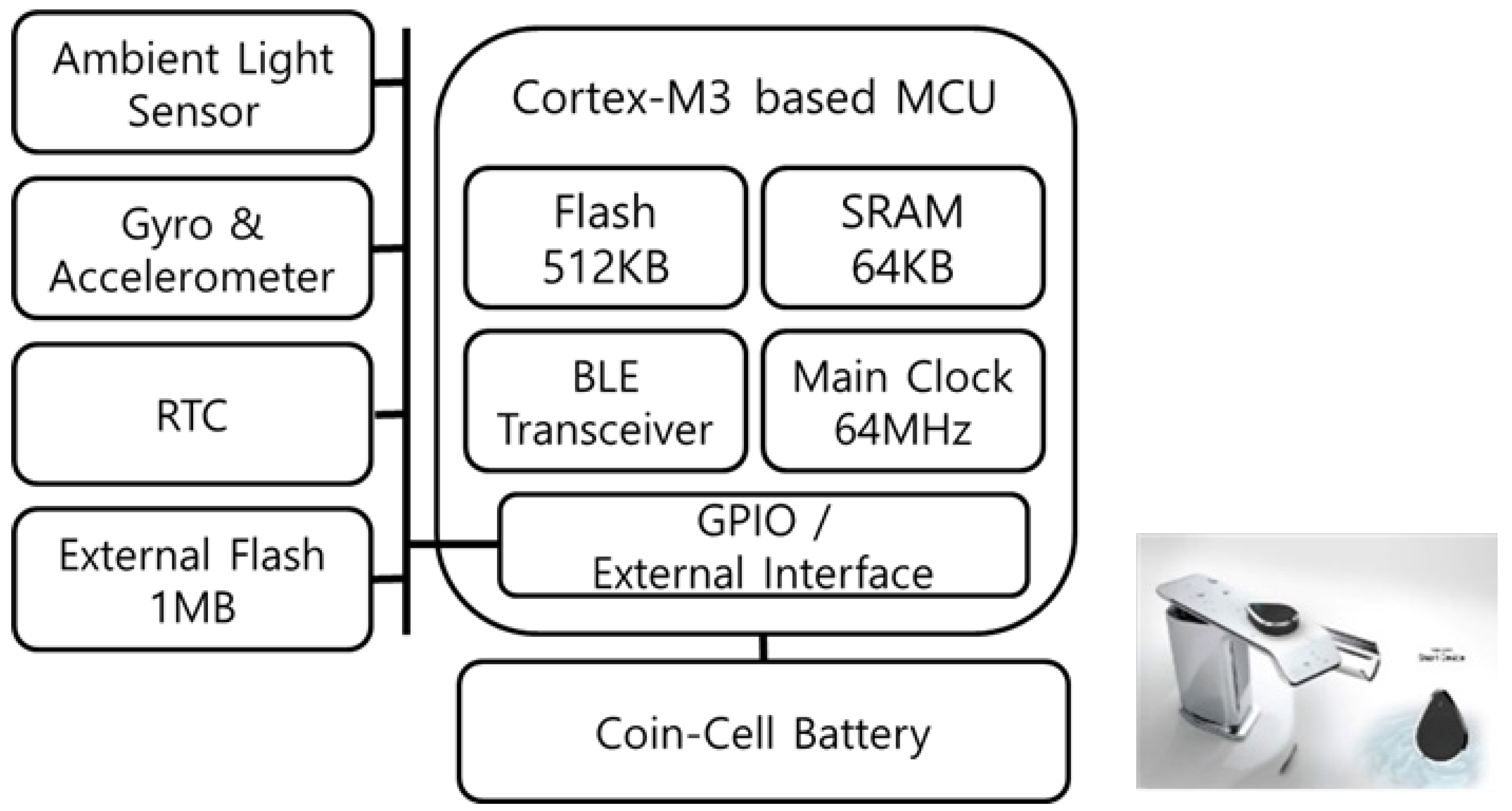

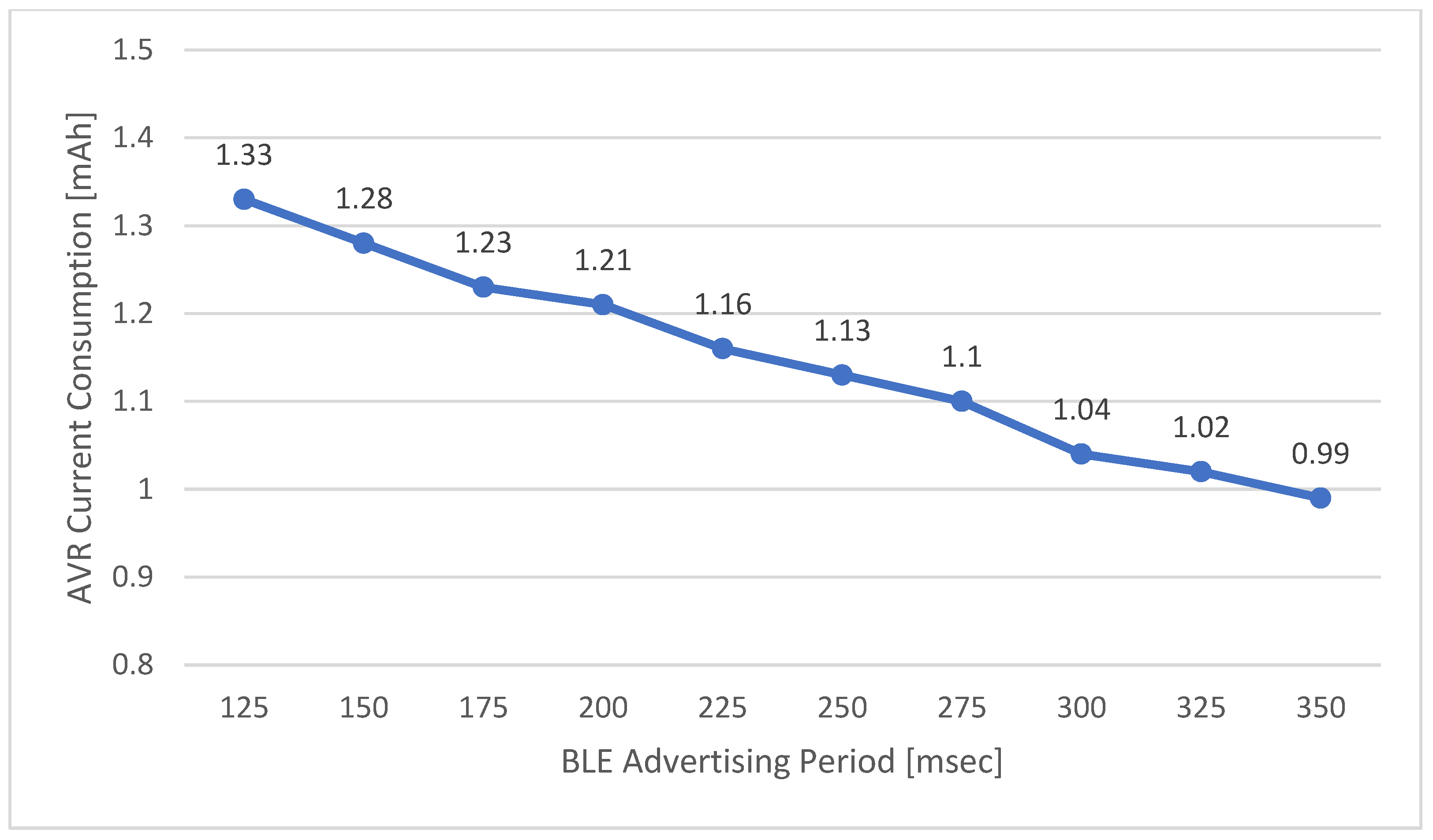
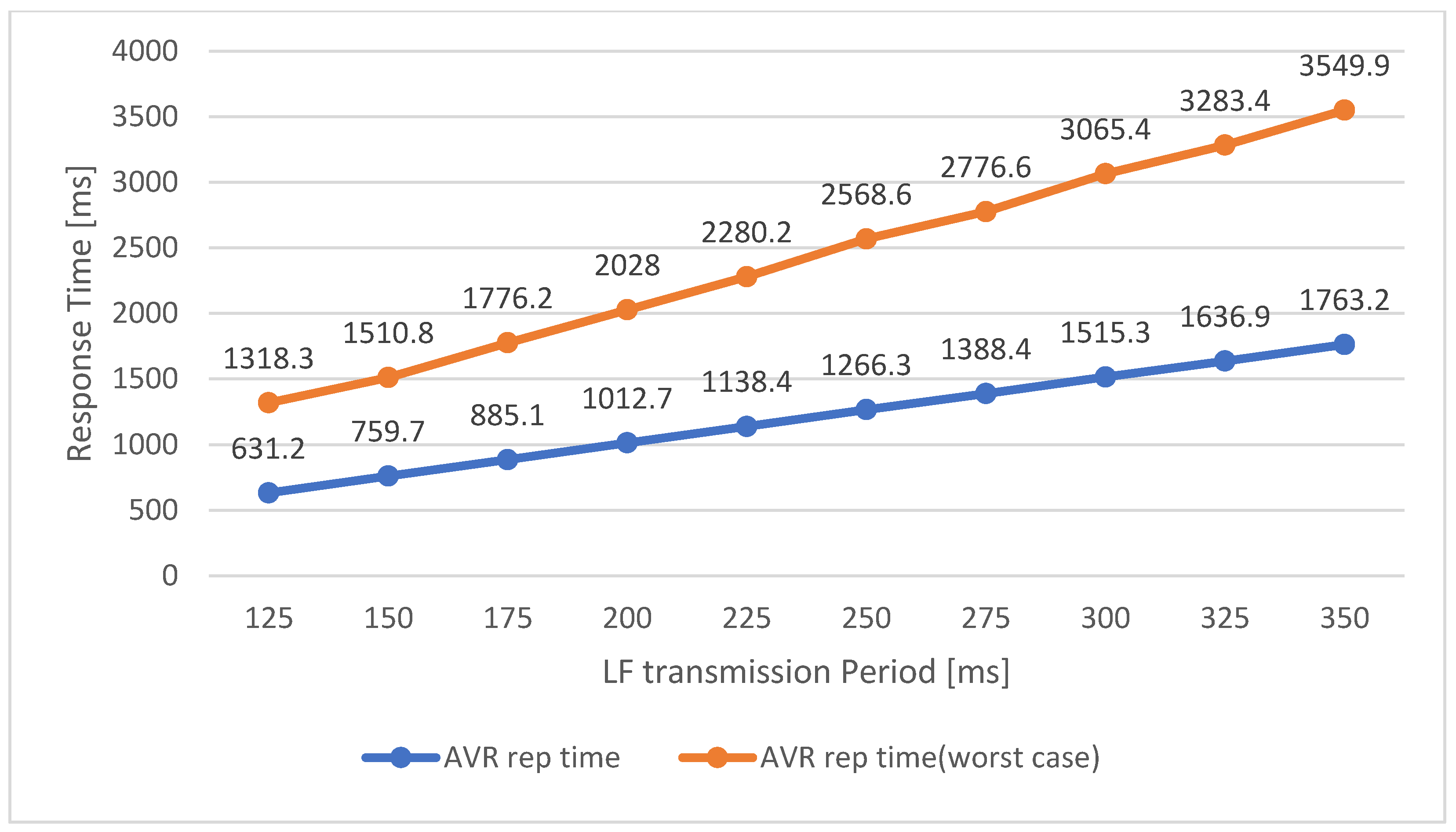

| Test Room 1 | Test Room 2 |
|---|---|
| 1. Test start (button input) 2. Enter Test Room 1 3. Enter toilet 4. Use toilet 5. Discard after using paper towel 6. Exit toilet 7. Use washstand 8. Use sphygmomanometer 9. Take medicine (smart pill reminder) 10. Exit Test Room 1 | 11. Enter Test Room 2 12. Use Gas Stove 13. Use Coffee port 14. Use Microwave 15. Exit Test Room 2 16. Enter Test Room 1 17. Test End (Button Input) |
| Service Name | Service ID(Hex) | Service Type | Service Name | Service ID(Hex) | Service Type |
|---|---|---|---|---|---|
| Blood Pressure | 0x01 | Resource | Body Fat Monitor | 0x0D | Resource |
| Weight | 0x02 | Resource | Vital Signal Alarm | 0x0E | Resource |
| Blood Sugar | 0x03 | Resource | SPO2 | 0x0F | Resource |
| Medication | 0x04 | Resource | Entrance | 0x10 | Resource |
| Door Lock | 0x05 | Resource | TAP Water | 0x11 | Resource |
| Gas Stove | 0x06 | Resource | Gas Tag | 0x12 | Resource |
| Fitness Equipment | 0x07 | Resource | Smart Toilet | 0x13 | Resource |
| Light Control | 0x08 | Resource | Smart Band | 0x14 | Mobile |
| Notification | 0x09 | Location Service | Smart Tag | 0x15 | Mobile |
| Business Card | 0x0A | Resource | Environment Sensor | 0x16 | Resource |
| Coffee Port | 0x0B | Resource | 433 MHz Sensor | 0x17 | Resource |
| Pedometer | 0x0C | Resource | Fitness Prescription | 0x18 | Resource |
| Index | Value(Hex) | Description |
|---|---|---|
| 0 | 0x02 | EAS Field Length |
| 1 | 0x01 | GAP_ADTYPE_FLAGS |
| 2 | 0x06 | GAP_ADTYPE_FLAGS_GENERAL(0x02) + GAP_ADTYPE_FLAGS_BREDR_NOT_SUPPORTED |
| 3 | 0x13 | EAS Field Length |
| 4 | 0xFF | GAP_ADTYPE_MANUFACTURER_SPECIFIC |
| 5 | 0x0D | MANUFACTURER ID0 |
| 6 | 0x00 | MANUFACTURER ID1 |
| 7 | 0x00 | Status Byte (0x00:Idle, 0x01: Identification, 0x02: For SMART Phone, 0x08: Location Request & Registration) |
| 8 | 0xXX | Device ID0 |
| 9 | 0xXX | Device ID1 |
| 10 | 0xXX | Device ID2 |
| 11 | 0xXX | Device ID3 |
| 12 | 0xXX | LF RSSI Value(0x00 ~ 0xFF dBm) |
| 13 | 0xXX | LAN MAC Address0 (Location Registration) |
| 14 | 0xXX | LAN MAC Address1 (Location Registration) |
| 15 | 0xXX | LAN MAC Address2 (Location Registration) |
| 16 | 0xXX | LAN MAC Address3 (Location Registration) |
| 17 | 0xXX | LAN MAC Address4 (Location Registration) |
| 18 | 0xXX | LAN MAC Address5 (Location Registration) |
| 19 | 0x15 | Packet Tx Profile Handle 0 |
| 20 | 0x00 | Packet Tx Profile Handle 1 |
| 21 | 0x14 | Packet Rx Profile Handle 0 |
| 22 | 0x00 | Packet Rx Profile Handle 1 |
| 23 | 0x13 | Packet Tx CCCD Handle 0 |
| 24 | 0x00 | Packet Tx CCCD Handle 1 |
| ADL Event | Activity Type | Success Ratio (%) | Success Time (s) | ||||
|---|---|---|---|---|---|---|---|
| Normal | MCI | Dementia | Normal | MCI | Dementia | ||
| Movement | Passage -> Room 1 | 100 | 100 | 100 | 5.87 | 8.97 | 11.52 |
| Movement | Room 1 -> Bathroom | 100 | 90.91 | 75 | 10.67 | 11.96 | 12.90 |
| Tool using | Toilet | 86.67 | 81.81 | 83.33 | 31.60 | 39.46 | 60.44 |
| Movement | Bathroom ->handbasin | 100 | 81.82 | 83.33 | 11.35 | 10.01 | 15.54 |
| Tool using | Hand washing | 93.33 | 100 | 41.67 | 20.75 | 29.44 | 25.78 |
| Tool using | Hand wiping | 100 | 90.91 | 41.67 | 20.15 | 18.60 | 24.84 |
| Tool using | Sphygmomanometer | 100 | 90.91 | 66.67 | 76.63 | 85.04 | 107.77 |
| Tool using | Pill reminder | 93.33 | 45.45 | 25.00 | 100.57 | 102.26 | 86.55 |
| Movement | Room ->Dining room | 100 | 72.73 | 16.67 | 35.27 | 88.06 | 90.10 |
| Tool using | Gas stove | 93.33 | 54.55 | 25 | 52.99 | 50.09 | 77.68 |
| Tool using | Coffee machine | 100 | 81.82 | 50 | 38.69 | 49.17 | 74.08 |
| Tool using | Microwave | 100.00 | 54.55 | 0.00 | 58.81 | 72.27 | 180.00 |
| Movement | Dining room -> Room | 100 | 81.82 | 50 | 49.98 | 69.28 | 180.00 |
Publisher’s Note: MDPI stays neutral with regard to jurisdictional claims in published maps and institutional affiliations. |
© 2021 by the authors. Licensee MDPI, Basel, Switzerland. This article is an open access article distributed under the terms and conditions of the Creative Commons Attribution (CC BY) license (http://creativecommons.org/licenses/by/4.0/).
Share and Cite
Park, Y.J.; Jung, S.Y.; Son, T.Y.; Kang, S.J. Self-Organizing IoT Device-Based Smart Diagnosing Assistance System for Activities of Daily Living. Sensors 2021, 21, 785. https://doi.org/10.3390/s21030785
Park YJ, Jung SY, Son TY, Kang SJ. Self-Organizing IoT Device-Based Smart Diagnosing Assistance System for Activities of Daily Living. Sensors. 2021; 21(3):785. https://doi.org/10.3390/s21030785
Chicago/Turabian StylePark, Yu Jin, Seol Young Jung, Tae Yong Son, and Soon Ju Kang. 2021. "Self-Organizing IoT Device-Based Smart Diagnosing Assistance System for Activities of Daily Living" Sensors 21, no. 3: 785. https://doi.org/10.3390/s21030785
APA StylePark, Y. J., Jung, S. Y., Son, T. Y., & Kang, S. J. (2021). Self-Organizing IoT Device-Based Smart Diagnosing Assistance System for Activities of Daily Living. Sensors, 21(3), 785. https://doi.org/10.3390/s21030785






